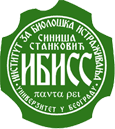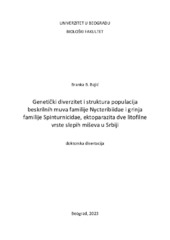Приказ основних података о документу
Genetički diverzitet i struktura populacija beskrilnih muva familije Nycteribiidae i grinja familije Spinturnicidae, ektoparazita dve litofilne vrste slepih miševa u Srbiji
Genetic diversity and population structure of bat flies of the family Nycteribiidae and mites of the family Spinturnicidae, ectoparasites of the two cavernicolous bat species in Serbia
| dc.contributor.advisor | Blagojević, Jelena | |
| dc.contributor.advisor | Paunović, Milan | |
| dc.creator | Bajić, Branka | |
| dc.date.accessioned | 2023-07-05T08:27:42Z | |
| dc.date.available | 2023-07-05T08:27:42Z | |
| dc.date.issued | 2023 | |
| dc.identifier.uri | http://radar.ibiss.bg.ac.rs/handle/123456789/5881 | |
| dc.description.abstract | Studija predstavlja prvo istraživanje genetičkog diverziteta mitohondrijskih gena beskrilnih muva i grinja, ektoparazita dve vrste slepih miševa, u Srbiji. Analizirani su sastav vrsta, specifičnost prema domaćinu i struktura populacija, te kvantitativni parametri parazitiranosti. Muve su testirane na prisustvo krvnog parazita Polychromophilus sp. čiji je genetički diverzitet takođe analiziran. Analizirani su genetički diverzitet i struktura populacija jedne vrste domaćina, M. schreibersii, koji su potom poređeni sa parametrima ektoparazita nađenih na njemu. Uzorci su prikupljeni sa 9 lokaliteta u Srbiji i Bosni i Hercegovini, sa ukupno 241 jedinke domaćina (Miniopterus schreibersii 168, Rhinolophus ferrumequinum 73). Prikupljeno je 369 jedinki beskrilnih muva (4 vrste) i 564 jedinki grinja (2 vrste), sa izuzetno izraženom specifičnošću prema primarnom domaćinu i bez ijednog zabeleženog slučaja unakrsne infekcije, uprkos činjenici da su domaćinske vrste povremeno delile skloništa. Domaćinska vrsta koja formira veće i gušće kolonije i migrira na veće distance, M. schreibersii, imala je veći intenzitet infekcije i diverzitet vrsta beskrilnih muva, a muve prikupljene sa nje imale su veći genetički diverzitet od muva prikupljenih sa drugog, manje mobilnog domaćina, R. ferrumequinum, u skladu sa očekivanjama. Parametri genetičkog diverziteta domaćina M. schreibersii i dveju ektoparazitskih vrsta, muve Nycteribia schmidlii i grinje Spinturnix psi nisu bili značajno korelisani. Infekcija parazitom Polychromophilus melanipherus detektovana je kod 33 beskrilne muve, od čega je samo jedna bila poreklom sa domaćina R. ferrumequinum - prvi takav slučaj zabeležen do sad. Potvrđen je značaj upotrebe ektoparazita koji se hrane krvlju u neinvazivnom testiranju populacija slepih miševa na prisustvo infekcija. | sr |
| dc.description.abstract | This study represents the first investigation of genetic diversity of mitochondrial genes of bat flies and mites, ectoparasites of two bat species, in Serbia. Species composition, host specificity, population structure and quantitative parameters of parasitism were analyzed. The flies were tested for the presence of the blood parasite Polychromophilus sp., whose genetic diversity was also analyzed. The genetic diversity and population structure of one host species, Miniopterus schreibersii, were analyzed and then compared with those of its ectoparasites. Samples were collected from 9 sites in Serbia and Bosnia and Herzegovina from a total of 241 host individuals (M. schreibersii 168, Rhinolophus ferrumequinum 73). 369 individuals of bat flies (4 species) and 564 individuals of mites (2 species) were collected, with a marked specificity for the primary host and without a single case of cross-infection recorded, despite the fact that the host species occasionally shared roosts. A host species that forms larger and denser colonies and migrates over longer distances, M. schreibersii, had a higher intensity of infection and species diversity of bat flies, and the flies collected from it had greater genetic diversity than those collected from the other, less mobile host R. ferrumequinum, as expected. The genetic diversity parameters of the host M. schreibersii and two ectoparasitic species, the bat fly Nycteribia schmidlii and the mite Spinturnix psi, were not significantly correlated. Infection with the parasite Polychromophilus melanipherus was detected in 33 bat flies, only one of which originated from the host R. ferrumequinum - the first such case recorded so far. The importance of using blood-feeding ectoparasites in non-invasive surveys of bat populations for the presence of infections was confirmed. | en |
| dc.language.iso | sr_lat | sr |
| dc.publisher | Belgrade: University of Belgrade, Faculty of Biology | sr |
| dc.relation | info:eu-repo/grantAgreement/MESTD/Basic Research (BR or ON)/173003/RS// | |
| dc.relation | info:eu-repo/grantAgreement/MESTD/inst-2020/200007/RS// | |
| dc.relation | “Monitoring skloništa i populacija slepih miševa Chiroptera u Srbiji” (broj 401-00-200/2016-17) | |
| dc.rights | openAccess | |
| dc.subject | Domaćin | sr |
| dc.subject | slepi miševi | sr |
| dc.subject | Miniopterus | |
| dc.subject | Rhinolophus | |
| dc.subject | ektoparaziti | sr |
| dc.subject | Nycteribiidae | |
| dc.subject | Spinturnicidae | |
| dc.subject | Haemosporidia | |
| dc.subject | Polychromophilus | |
| dc.subject | mtDNK | |
| dc.subject | Host | en |
| dc.subject | bats | en |
| dc.subject | ectoparasites | en |
| dc.title | Genetički diverzitet i struktura populacija beskrilnih muva familije Nycteribiidae i grinja familije Spinturnicidae, ektoparazita dve litofilne vrste slepih miševa u Srbiji | sr |
| dc.title | Genetic diversity and population structure of bat flies of the family Nycteribiidae and mites of the family Spinturnicidae, ectoparasites of the two cavernicolous bat species in Serbia | en |
| dc.type | doctoralThesis | en |
| dc.rights.license | BY-NY-SA | |
| dc.rights.holder | © 2023 by the author | |
| dc.citation.vancouver | Bajić B. Genetic diversity and population structure of bat flies of the family Nycteribiidae and mites of the family Spinturnicidae, ectoparasites of the two cavernicolous bat species in Serbia [dissertation]. Belgrade: University of Belgrade, Faculty of Biology; 2023. 125 p. | |
| dc.citation.spage | 1 | |
| dc.citation.epage | 125 | |
| dc.type.version | publishedVersion | |
| dc.identifier.fulltext | https://radar.ibiss.bg.ac.rs/bitstream/id/13914/Branka_Bajic-dissertation.pdf | |
| dc.identifier.rcub | https://hdl.handle.net/21.15107/rcub_ibiss_5881 |

